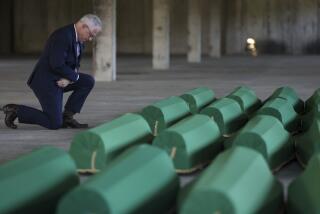In Bosnia, a Numbing Rescue Redux : Evacuation: U.N. airlifts out of besieged cities like Gorazde have become a tragic routine as Serb aggression continues.
- Share via
SARAJEVO, Bosnia-Herzegovina — Whirring helicopter blades churned up a deafening windstorm as blue-helmeted U.N. troops ferried stretchers bearing bandaged children and stubble-faced fighters with crudely amputated limbs.
They were the first of hundreds of casualties whisked from Gorazde to Sarajevo for treatment Sunday, but shuttling broken bodies from one hellish war zone to the ruins of another has become a tragic routine for the U.N. peacekeeping force.
Exactly a year ago, U.N. troops and humanitarian relief workers evacuated maimed Muslims from Srebrenica, where a brutal offensive like the campaign against Gorazde inflicted grave injury and terror on that population.
And some observers fear that there will be other Srebrenicas and Gorazdes as the Bosnian Serbs, seemingly undaunted by threats of air strikes, continue their drive to “ethnically cleanse” the area and create a Greater Serbia.
Only a few months ago the choppers airlifting maimed civilians were headed out of Sarajevo, not in. That Gorazde’s casualties can be accommodated in this battered capital of Bosnia-Herzegovina is testimony both to the improved security here since shelling was stopped by a North Atlantic Treaty Organization ultimatum and the sad reality that two years of savagery have taught medical workers to take massacres in stride.
“It would be a shame on all of us to fail in dealing with this crisis after the experiences of sudden tragedies we have already endured,” Osman Duric, the chief surgeon at Kosevo Hospital, told his medical staff a few hours before the wounded began to arrive.
When the first three British Sea Kings roared into nearby Zetra stadium, hundreds of French, Ukrainian, Swedish and other soldiers set up a stretcher relay. Triage doctors dispatched the wounded to a fleet of waiting ambulances and then braced themselves for the next round.
Even the shellshocked children brought out without their parents were visibly relieved at having escaped the horrors of Gorazde.
Nine-year-old Emina Dizdarevic, her right eye gouged by shrapnel and covered with a dirty bandage, said her father was killed during the war’s first year and her brother lost as their family was uprooted.
For Medina Dzananovic, an 8-year-old wounded when shrapnel struck her head, even a few hours more in devastated Gorazde might have dangerously worsened her condition, doctors said.
Almir Sarajlic, an 18-year-old wounded on the defense lines the first day the Serbian assault began, suffered an emotional blow as he was evacuated Sunday.
“I didn’t know our house had been burned until I saw it from the air as we lifted off,” the conscript said.
His family had been driven out of their village in the first days of the Serbian incursion. The rebels torched the Muslim houses to ensure that their victims would never return.
“It’s a nightmare,” said Mary McLaughlin, an Irish doctor who had been trapped in the city since the onslaught began. “It was very frustrating as a doctor because we could do very little. For five days we couldn’t even go out.”
One official of the United Nations’ refugee agency noted the similarity between rebel sabotage in the two “safe havens” of Gorazde and Srebrenica, where water facilities were blown up as the Bosnian Serbs were forced to retreat.
“Our fear is that Gorazde is even less viable now than Srebrenica,” he said. “There are more people in what is effectively an even smaller place.”
More to Read
Sign up for Essential California
The most important California stories and recommendations in your inbox every morning.
You may occasionally receive promotional content from the Los Angeles Times.














